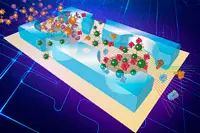Electronics News
Archive : 8 October 2014 год
 A tiny biomedical device has been created which, according to its developers, could detect cancer more quickly and in a less invasive way than before.
A tiny biomedical device has been created which, according to its developers, could detect cancer more quickly and in a less invasive way than before.
The lab-on-a-chip works by detecting minuscule membrane vesicles called exosomes, which are found in most cancer cells,
Until now, exosomes have been hard to separate out and test because of their small size (between 30 and 150nm).
Now, however, a team from the University of Kansas has created a device that promises faster result times, reduced costs, minimal sample demands and better sensitivity of analysis compared to conventional bench-top instruments currently used to examine the tiny biomarkers.
The prototype lab-on-a-chip is made of a widely used silicone rubber called polydimethylsiloxane and utilises a technique called on-chip immunoisolation.
"We used magnetic beads of 3µm in diameter to pull down the exosomes in plasma samples," said Yong Zeng, an assistant professor of chemistry at the University of Kansas. "In order to avoid other interfering species present in plasma, the bead surface was chemically modified with an antibody that recognises and binds with a specific target protein – for example, a protein receptor – present on the exosome membrane.
"The plasma containing magnetic beads then flows through the microchannels on the diagnostic chip in which the beads can be readily collected using a magnet to extract circulating exosomes from the plasma."
The device is currently being developed to detect lung cancer, although Zeng says it has the potential to detect different forms of the disease.
"Our technique provides a general platform to detecting tumour derived exosomes for cancer diagnosis," he continued. "In addition to lung cancer, we've also tested for ovarian cancer in this work. In theory, it should be applicable to other types of cancer."
Author
Laura Hopperton
Source: www.newelectronics.co.uk
 The University of Oxford, a member of the Low Frequency Aperture Array consortium, which is working with the Square Kilometre Array Organisation to build the world's largest radio telescope, has signed the second phase of a study contract with RFEL. This new contract focuses on the design of an FPGA based signal processing architecture for beam forming functions in the antenna processing hardware.
The University of Oxford, a member of the Low Frequency Aperture Array consortium, which is working with the Square Kilometre Array Organisation to build the world's largest radio telescope, has signed the second phase of a study contract with RFEL. This new contract focuses on the design of an FPGA based signal processing architecture for beam forming functions in the antenna processing hardware.
The first phase of the study concentrated on designing a maximum performance, minimum complexity, channeliser for subdividing the radio spectrum. RFEL is now investigating whether its beam forming IP, used to image distant sources, can be combined with the channeliser to further boost performance and minimise resource usage.
Alex Kuhrt, RFEL's CEO, said: "We are delighted to continue working on this international project in such a key role. The SKA will comprise thousands of dish telescopes and hundreds of thousands of dipole antennas. Each dipole antenna will have two of these channelisers – one for each polarisation – to process the signals. It is therefore vital to keep the power requirement and cost of each processing card to a minimum, which is our speciality."
RFEL is also considering using its ChannelCore Flex architecture, with its flexibility to arbitrarily define the centre frequency, bandwidth and sample rate of potentially thousands of independent radio channels to ensure that all available processing resources and data bandwidth are used to maximum effect.
Author
Graham Pitcher
Source: www.newelectronics.co.uk

